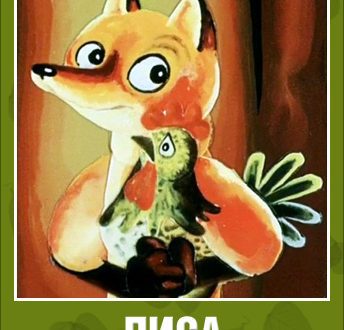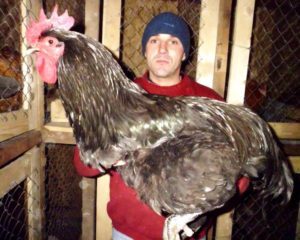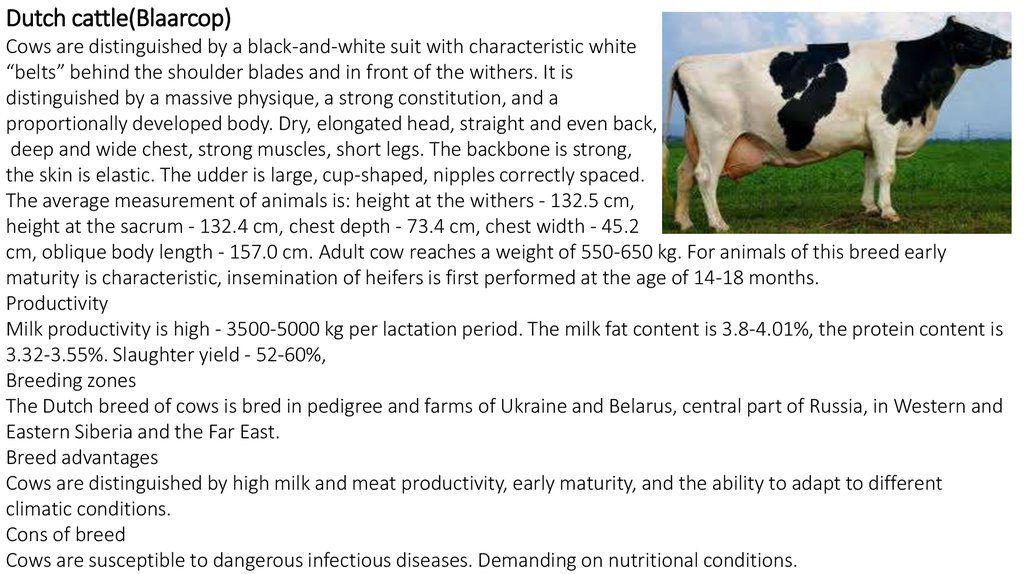
Rasa de vaci de lapte alb-negru: avantaje, dezavantaje și productivitate
In Russian farms, among the breed of cows, dairy species that give very large milk yields are not so common. Relatively recently, one interesting, motley-black breed has appeared, which at the moment occupies the third place in terms of distribution after such breeds as red cattle and Simmental. The black-and-white breed is bred throughout Russia.
Cuprins
The origin of the black-and-white breed of cows
The progenitors of such cows are representatives of the Dutch and East Frisian breeds. Everything contributed to the fact that in the XNUMXth and XNUMXth centuries a new breed appeared in the Netherlands: a mild climate, excellent nutrition, and the interest of producers to raise dairy cattle.
At first, such animals were distinguished by great susceptibility to various diseases, weak immunity, fragile physique, although they gave a lot of milk. However, thanks to the help of breeders, by the twentieth century they became stronger, and the quality characteristics of their meat also increased.
The first representatives of black-and-white cows appeared in the Russian state at the end of the 1917th century in some landlord farms. However, only after XNUMX Soviet scientists saw great potential in such cows, as a result of which they began to very quickly win places in the farms of the peasants.
In 1959, at the request of Soviet breeders, black-spotted cattle were singled out as a separate breed.
Appearance of a black-and-white cow
The name of the breed came from the color of the cows: the black skin of the animal is covered with randomly arranged white spots of different sizes.
In addition to the powerful physique characteristic of the dairy representatives of the oblong body, this breed has other appearance features:
- a long head with an elongated muzzle, gray horns have a dark color at the ends;
- medium length, non-muscular neck all in folds;
- the chest is not too wide;
- the back is fairly even, with a straight loin and a wide sacrum;
- limbs are even, strong, stable;
- voluminous belly, cup-shaped udder, unevenly developed lobes, rear nipples are very close.
The height at the withers of a dairy cow is 130–132 cm.
Depending on the areas of residence, this breed has different types:
- cows from the central region of the country are distinguished by a rather large physique. An adult cow weighs 550–650 kg, and a bull weighs 900–1000 kg, and in some cases even more. Thus, in addition to milk, these animals also give a lot of meat.
- Ural animals have a dry type of constitution, resulting in a light and harmonious look.
- cows from Siberia are much smaller than animals from the central regions and it is not as dense as individuals from the Urals. The average weight of an adult representative is 500-560 kg.
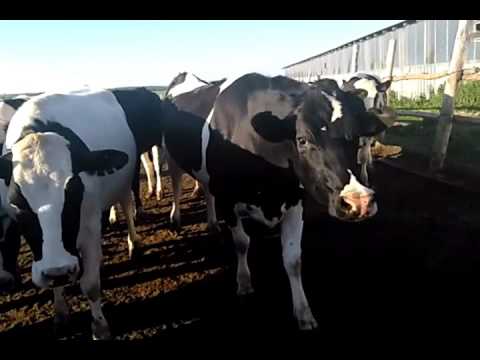

Urmăriți acest videoclip pe YouTube
Caracteristica productivității
Black-and-white calves weigh 37 kg (heifers) and 42 kg (calves) at birth. They love to eat, so every day they put on weight 600–800 g each. With a more abundant diet, calves can add a kilogram per day. At 15 months, the weight of babies is already more than 420 kg. The largest cubs can weigh 480 kg. Young bulls can eat so much that they catch up with their peers of meat breeds by weight.
Regardless of the area of residence, bulls reach a weight of 900 kg, and sometimes even exceed a ton. An adult dairy cow is also quite heavy and its weight ranges from 500–650 kg.
It’s nice that such a result is achieved without the high cost of purchasing special concentrates. Summer animals graze on green pastures, in winter they feed on hay and succulent additives.
This breed is valued by the fact that cows give very large milk yields. Animals living in different regions of the country differ in different indicators of milk yield. This is influenced not only by the climate of the region of residence, but also by the conditions of keeping and feeding.
Dairy animals of leading breeding farms in the central region of Russia produce up to 8000 kg of milk per year, with a fat content of about 3,7% and a protein content of 3,0 to 3,2%. Dairy cows from the Siberian region also have good statistics: advanced farms receive 8000 kg of milk per year, however, its fat content reaches 3,9%, protein – 3%. In terms of milk yield, Ural animals are inferior to cows from the Siberian and central regions, giving 2 kg of milk per year with a fat content of 5500% and a protein content of 4%. Under normal conditions cows are able to give 3,47-3000 kg of milk.
These features are related to each other. For example, The fat content of milk directly depends on the volume of milk yield., and it, in turn, depends on the mass of live weight, which depends on the amount of feed consumed.
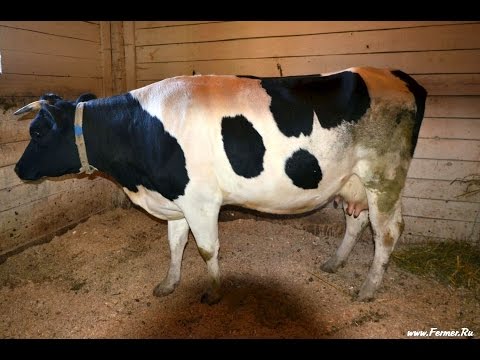

Urmăriți acest videoclip pe YouTube
Advantages and disadvantages of black-and-white cows
Cows of this breed, as the best representatives of the dairy direction, bring more profit to farmers from the sale of dairy products. Also, many farmers rely on their amazing ability to quickly gain weight.
In addition, this breed has other advantages:
- good health;
- the ability to quickly acclimatize in a new environment;
- moderate precocity with the ability to build muscle mass by eating food with a small amount of concentrated additives;
- fatty milk and lean meat.
There are such cows and disadvantages. They are, of course, insignificant, but farmers are fighting with them. It is as follows:
- elimination of the main differences between breed types;
- the creation of taller and larger animals;
- increase in quantitative indicators of milk yield;
- an increase in the fat content of milk and the protein content in it.
In addition, cows actively respond to a good attitude towards her. Quality care helps her turn into a cow that gives high milk yields. If the attitude towards her is careless, then high milk yields are not to be expected.
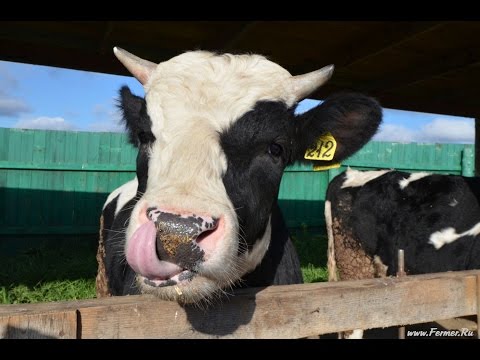

Urmăriți acest videoclip pe YouTube
Concluzie
Domestic farmers are very fond of black-motley cows, therefore you can buy them in any region our country. The owner of such a cow should not forget that this is still a rather large breed that requires a spacious room, as well as a large amount of hay and grass. The effort, money and time invested in it must definitely pay off and turn into a good profit.





